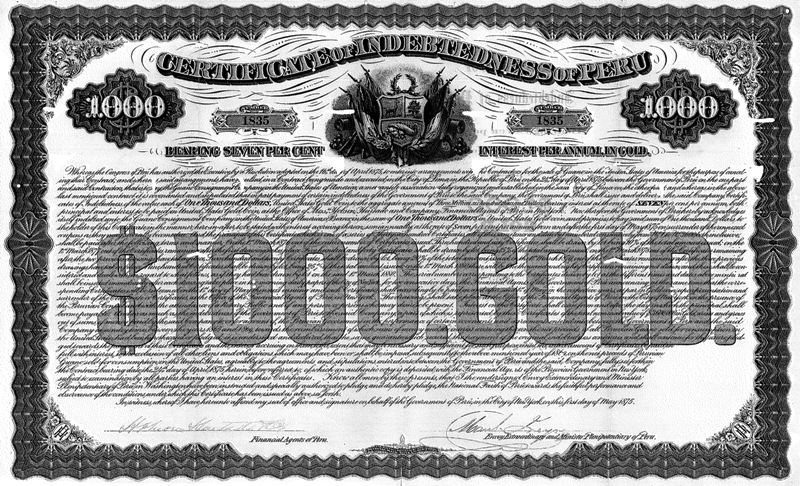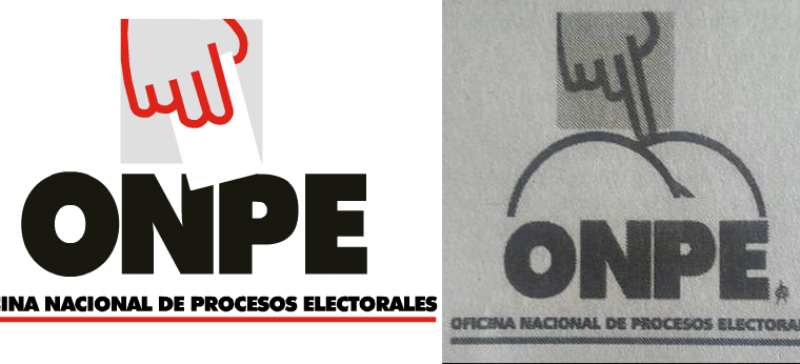An Illinois firm has sued the government of Peru for $182 million for its failure to pay 140-year-old sovereign bonds from the guano era.
Bloomberg reports that a lawsuit from MMA Consultants 1 claims that repeated attempts to redeem the bonds were ignored by Peru’s finance ministry and the Peruvian embassy in the United States. The bonds denominated in $1,000 gold coins bearing 7% interest were issued in 1875, at the end of Peru’s guano boom.
The bonds were signed by Manuel Freyre, Peru’s ambassador to the United States whose title at the time was “Envoy Extraordinaire and Plenipotentiary Minister of Peru.”
Peru issued the bonds to pay off a U.S. guano consignment company when the country’s debt service costs ran at 50% of the national budget. Peru defaulted on its sovereign debt in 1876, less than a year from the bonds’ issue.
It is not clear how MMA Consultants 1 obtained the 140-year-old bonds. The company seems to have been created only to sue Peru in U.S. courts. It was incorporated last year by William Smith at a residential address in Schaumberg, a suburb of Chicago. The company is currently not in good standing according to Illinois public records, which implies it has not renewed its LLC status for 2015.
Despite the questionable nature of the lawsuit, the bonds present a difficult situation for Peru if they are authentic. While Peru has defaulted several times since 1875, including a perpetual state of default lasting from 1984 to 1997, the country currently enjoys investment-grade rating from all three major ratings agencies.
As amusing as the current lawsuit seems, Peru will probably issue new sovereign debt in the coming years in order to boost public spending during an economic slowdown. If the New York court rules that Peru must pay Smith’s MMA Consultants 1, Peru would have to decide whether to reach a settlement or risk a possible downgrade.
Peru enjoyed a monopoly on the world market for guano, seabird dung used for fertilizer in the United States and Europe, from the 1840s to the early 1870s. The monetary windfall, which multiplied the government’s budget by seven in 20 years, is estimated to have been greater than modern-day oil states’ such as Venezuela and Nigeria.
A study by American economist Shane Hunt revealed that over half of the guano era revenue funded public sector expansion, while 20% of royalties built Peru’s railroads. Over 90,000 Chinese immigrants came to Peru during the era to help build the railroads.
Peru fought the brief Chincha Islands War with Spain over the three islands off Peru’s southern coast where the seabirds’ guano collected.
By the time Peru issued the bonds at the heart of MMA Consultants 1’s lawsuit, the use of guano as a fertilizer was being replaced by saltpeter from the Atacama desert, which formed part of Bolivia. Saltpeter deposits largely inspired the War of the Pacific, in which Chile won the port city of Arica from Peru and shut Bolivia off from the Pacific Ocean.
Sources
Peru Haunted by 7% Guano Bonds Predating Machu Picchu Discovery (Bloomberg)
CORPORATION FILE DETAIL REPORT (Illinois Secretary of State)
PERU’S EXPERIENCE IN SOVEREIGN DEBT MANAGEMENT AND LITIGATION: SOME LESSONS FOR THE LEGAL APPROACH TO SOVEREIGN INDEBTEDNESS (Duke University)
Historia del Perú Contemporáneo (Instituto de Estudios Peruanos)








